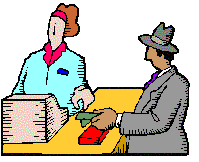The thoughts of a job interview are enough to turn veteran job hunters to jelly. For a teen or someone similar in age, the thought of interviewing for a job is more frightening than having to tell Dad you lost the car keys—again.
 Interviewing for a job doesn’t have to be that scary, though. Some thought and preparation go a long way in relieving your anxiousness over going for a job interview. You’ll still be nervous, everyone is, but using these quick tips will help.
Interviewing for a job doesn’t have to be that scary, though. Some thought and preparation go a long way in relieving your anxiousness over going for a job interview. You’ll still be nervous, everyone is, but using these quick tips will help.
- You know about yourself, but finding out as much as possible about a potential employer will help you feel more secure in what you have to offer that employer as an employee. So research the company for as many facts about it as possible.
- Ask a friend or parent who has been through a job interview (or several) to be the employer and act out (in this case, acting out is a good thing) an interview session. Have them be a tough interviewer and you’ll be even better prepared.
- Be sure you have great directions to the interview site. The last thing you want to have to worry about the day of the interview is how to get there or, worse, to get lost and be late.
- Yes, be on time. Being late may not cost you the job, but it will definitely make it harder to get the job. Especially when Jacks and Jane, numbers 1-250, were 30 minutes early!
- Take several clean copies of your resume along. Three is a good number of copies to take with you. Even when an employer already has a copy of your resume, you want to be prepared to give him or her a new one, plus ones for anyone the person may report to or share the decision-making process with.
- Get plenty of rest the night before. Don’t go into an interview tired and worn out. You want to be fresh and ready to tackle the world! At least that’s the impression you want a potential employer to have of you.
- Dress up. This cannot be stressed enough. Even if the company where you’ll be interviewing has a relaxed dress code, you want to look professional when you interview and want to dress at least one level above the company’s dress code (if you don’t know about a company’s dress code, research or go all out in dressing up). No jeans, shirt tails hanging out, flip-flops or tongue rings, nose rings, etc. And if you have tattoos, it’s best that they’re covered up when you go for the interview.
- Turn your cell phone off! Having your cell phone ring during a job interview is even worse than having it go off during class or church services. It’s a big no-no and will make you seem thoughtless in the “ears” of a potential employer.
Finally, expect to be nervous. Rather than fight your nervousness, use it to energize yourself. Remind yourself of all the things you do, and have done, well. Believe in yourself and the interviewer is sure to believe in you too!






 In general, a financial audit will seek to confirm that the company used “generally accepted accounting principles” (GAAP) in the scope of the audit (all material information has been revealed), how the finances of the company have been managed and what are the kind and strength of the company’s internal financial control structures for reporting and protecting assets. A proper audit will seek to confirm that all the financial data of the company has been reliably obtained, maintained and disclosed in the reports, and that the resources of the firm are properly protected against losses arising from fraud, theft, error or mismanagement.
In general, a financial audit will seek to confirm that the company used “generally accepted accounting principles” (GAAP) in the scope of the audit (all material information has been revealed), how the finances of the company have been managed and what are the kind and strength of the company’s internal financial control structures for reporting and protecting assets. A proper audit will seek to confirm that all the financial data of the company has been reliably obtained, maintained and disclosed in the reports, and that the resources of the firm are properly protected against losses arising from fraud, theft, error or mismanagement. Entering the High School years, ninth and tenth grade students now have the opportunity to pick and choose classes they find interesting and want to learn more about. Many students decide to take Economics (see
Entering the High School years, ninth and tenth grade students now have the opportunity to pick and choose classes they find interesting and want to learn more about. Many students decide to take Economics (see  Seventh and eighth grade students now have the skills of addition, subtraction, multiplication, and division and know how to compute all these operations with money and decimals. The next part of learning about money and financing is geared more toward the business aspect.
Seventh and eighth grade students now have the skills of addition, subtraction, multiplication, and division and know how to compute all these operations with money and decimals. The next part of learning about money and financing is geared more toward the business aspect. Fifth and sixth grade students now have the skills of addition, subtraction, multiplication, and division. They can recognize monetary values and can use their learned skills in real life situations. Teachers in the prior grades have introduced multiplication and division of money and now the students will learn the decimal rules pertaining to this concept.
Fifth and sixth grade students now have the skills of addition, subtraction, multiplication, and division. They can recognize monetary values and can use their learned skills in real life situations. Teachers in the prior grades have introduced multiplication and division of money and now the students will learn the decimal rules pertaining to this concept. Students have learned all the coin and dollar amounts prior to entering second grade (see
Students have learned all the coin and dollar amounts prior to entering second grade (see  Finding Aide
Finding Aide